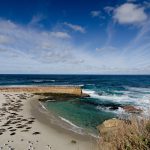Wheeler North Reef
Coastal Environments (CE) was retained by Southern California Edison (SCE) to provide construction management for a 174.4 acre artificial reef, the Wheeler North Reef (WNR) located at San Clemente, California. This was the largest single-layer, artificial kelp reef ever constructed. CE provided design services, engineering support, construction management, and construction verification, as well as acting as the liaison between the construction company (Connolly-Pacific), the client (SCE), and the lead agency (the California Coastal Commission). The WNR was constructed to mitigate for kelp and associated biota losses resulting from operation of the San Onofre Nuclear Generating Station in San Onofre, California.
The 174.4 acre reef is composed of 56 40 x 40m blocks from Phase 1 (22.4 acres), and 17 polygons from Phase 2 (152.0 acres). Technical specifications for design of the reef were completed by CE and approved by the permitting agencies. Specifications included: Size distribution of the rocks, rock density and porosity, and multiple reef location criteria. The reef was composed of 126K tons of metamorphosed volcanic or granitic rock from quarries on Santa Catalina Island or Ensenada, Mexico. The reef was constructed in a single-layer of less than 1 meter and has a percent coverage of hard substrate on the seafloor of 42%. Research has shown that a low relief reef is more effective as an environment for kelp, so another criteria of construction was that there would be less than 15% overlap of rocks, Both bathymetric and diver transects conducted by CE showed that almost no overlap occurred.
A derrick barge, moored by six anchors, was utilized to assist in placing the reef materials per the engineering design specifications. Two Global Positioning Satellite (GPS) systems were utilized to locate the two barges in the correct position. The rock supply barges were attached to the derrick barge and the boulders were cast upon the seafloor along pre-plotted survey lines via a front loader.
Construction control and verification included a) On-site monitoring, b) GPS surface surveying of the rock placement locations, c) Multi-beam sonar verification, and d) Diver surveys. Photographs were taken daily to document the construction process and to monitor ocean turbidity. Compliance with all applicable permit conditions was achieved. The Phase 2 reef was successfully constructed in only 73 field days.
Client
Southern California Edison




